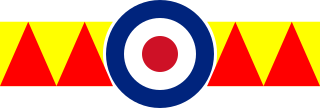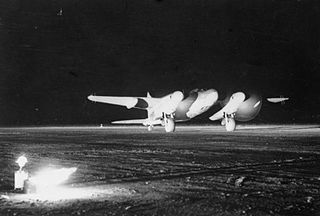
No. 1435 Flight Royal Air Force, commonly abbreviated 1435 Flt, is an independent aircraft flight of the Royal Air Force (RAF). Currently operating the Eurofighter Typhoon FGR4, it is based at RAF Mount Pleasant in the Falkland Islands. Its role is to provide air defence for the Falkland Islands, South Georgia and the South Sandwich Islands. Four aircraft are permanently based in the islands, whilst their pilots and groundcrew are cycled through No. 1435 Flight from the various Typhoon squadrons in the United Kingdom, providing a 24-hour, 365-day quick reaction alert (QRA) role.

Number 54 Squadron is a squadron of the Royal Air Force based at RAF Waddington, Lincolnshire. On 1 September 2005, it took on the role of Intelligence, Surveillance and Reconnaissance (ISR) Operational Conversion Unit, and is now the Advanced Air ISTAR Academy, responsible for training all RAF crews assigned to the MQ-9A Reaper, Protector RG1 (MQ-9B), Shadow R1/R2, RC-135W Rivet Joint and Poseidon MRA1. It also controls the RAF ISR Warfare School (ISRWS) who run the Qualified Weapons Instructor Intelligence, Surveillance and Reconnaissance and QWI Reaper Courses.

Royal Air Force West Malling or more simply RAF West Malling is a former Royal Air Force station located 1.6 miles (2.6 km) south of West Malling, Kent and 5.2 miles (8.4 km) west of Maidstone, Kent, England.

No. 603 Squadron is a squadron of the Royal Auxiliary Air Force, based in Edinburgh, Scotland. On reforming on 1 October 1999, the primary role of 603 Squadron was as a Survive to Operate squadron, as well as providing force protection.
No. 515 Squadron RAF was a squadron of the Royal Air Force formed during the Second World War. It ushered in Electronic countermeasures (ECM) warfare, jamming enemy radar installations from October 1942 as the only such squadron in the RAF initially. Later in the war 515 Sqn was joined by other squadrons as part of No. 100 Group RAF. The squadron disbanded after VE day, when the need for such a specialised squadron had reduced.

Number 45 Squadron is a flying squadron of the Royal Air Force. The squadron, which was established on 1 March 1916 as part of the Royal Flying Corps, currently provides flying training using Embraer Phenom T1s and operates under the command of No. 3 Flying Training School at RAF Cranwell, Lincolnshire.

No. 151 Squadron was a squadron of the Royal Air Force.

No. 247 Squadron was formerly a squadron of the Royal Air Force. It was also known as No. 247 Squadron in recognition of the donations made by the British communities of the foreign concessions established on the Chinese coast. The financial gift to provide two fighter squadrons also included the badge in the form of a scroll with Chinese characters Cheu Feng meaning "fierce wind" or Hurricane, and the motto "Rise from the East". The squadron was heavily involved in air operations during the Second World War, and the defence of the United Kingdom during the early years of the Cold War.

No. 504 Squadron was one of the Special Reserve Squadrons of the Auxiliary Air Force, and today is a reserve force of the RAF Regiment. It was integrated into the AAF proper in 1936. Based at RAF Cottesmore, Rutland, 504 Squadron used a variety of light bombers before being re-tasked to fighters with the Hawker Hurricane in 1939. It subsequently became a Fighter Squadron. Currently No. 504 Squadron no longer has a flying role, but as part of No 85 Expeditionary Logistics Wing of the RAF A4 Force.

The name No. 68 Squadron has been used for two quite different units, only one of which was strictly a unit of the Royal Air Force. "No. 68 Squadron RFC" was for a time the official British military designation for No. 2 Squadron Australian Flying Corps.

No. 89 Squadron was a Royal Air Force squadron, mainly active in the fighter role during its existence.

No. 307 (Polish) Squadron, also known as No. 307 Squadron was a Polish squadron formed in Great Britain as part of an agreement between the Polish Government in Exile and the United Kingdom in 1940. It was one of 15 squadrons of the Polish Air Force in exile that served alongside the Royal Air Force in World War II. It was the only Polish night fighter squadron in RAF service. It was named after the Polish city of Lwów, and was nicknamed "Eagle Owls".

No. 85 Squadron was a squadron of the Royal Air Force. It last served in 2011, as No. 85 (Reserve) Squadron posted to RAF Church Fenton.

No. 264 Squadron RAF, also known as No. 264 Squadron, was a squadron of the Royal Air Force.

No. 65 Squadron was a squadron of the Royal Air Force.

No. 604 Squadron RAF was a squadron of the Royal Air Force noted for its pioneering role the development of radar-controlled night-fighter operations. The squadron was established in March 1930 at RAF Hendon as a day-bomber squadron of the Royal Auxiliary Air Force. In July 1934, the squadron transitioned to two-seat fighters. Shortly after the commencement of World War II in 1939, the squadron was reassigned to a night-fighter role.

No. 256 Squadron RAF was a flying squadron of the Royal Air Force which operated during the First and Second World Wars. Initially equipped with Dh6 and Kangaroo aircraft, it operated Defiant Mk IIs, Beaufighters, and Mosquitoes in the Second World War.
No. 248 Squadron was a squadron of the Royal Air Force, active immediately after World War I, and again during World War II.

Number 125 (Newfoundland) Squadron was a Royal Air Force squadron active during World War II and briefly in the mid-1950s. Throughout its service the squadron primarily operated night fighters.

No. 255 Squadron RAF was a Royal Air Force Squadron formed as an anti-submarine unit in First World War and a night-fighter unit in the Second World War. The First World War squadron was formed from former Royal Naval Air Service coastal flights and was responsible for coastal anti-submarine patrols. It was disbanded after the war.


















